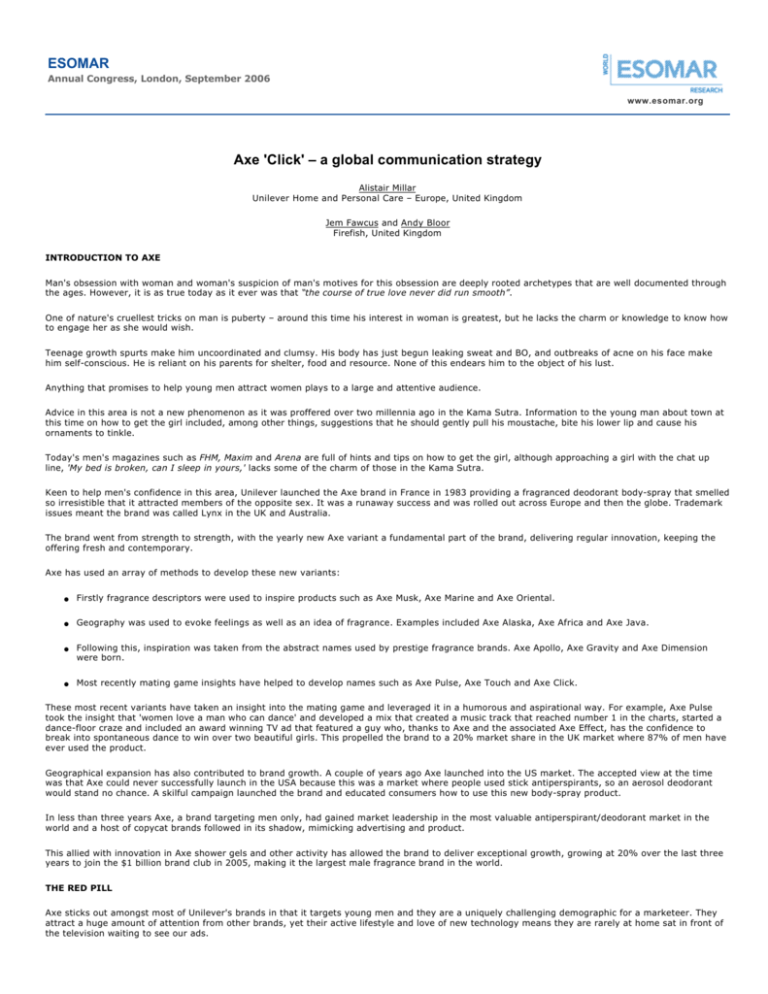
ESOMAR
Annual Congress, London, September 2006
www.esomar.org
Axe 'Click' – a global communication strategy
Alistair Millar
Unilever Home and Personal Care – Europe, United Kingdom
Jem Fawcus and Andy Bloor
Firefish, United Kingdom
INTRODUCTION TO AXE
Man's obsession with woman and woman's suspicion of man's motives for this obsession are deeply rooted archetypes that are well documented through
the ages. However, it is as true today as it ever was that “the course of true love never did run smooth”.
One of nature's cruellest tricks on man is puberty – around this time his interest in woman is greatest, but he lacks the charm or knowledge to know how
to engage her as she would wish.
Teenage growth spurts make him uncoordinated and clumsy. His body has just begun leaking sweat and BO, and outbreaks of acne on his face make
him self-conscious. He is reliant on his parents for shelter, food and resource. None of this endears him to the object of his lust.
Anything that promises to help young men attract women plays to a large and attentive audience.
Advice in this area is not a new phenomenon as it was proffered over two millennia ago in the Kama Sutra. Information to the young man about town at
this time on how to get the girl included, among other things, suggestions that he should gently pull his moustache, bite his lower lip and cause his
ornaments to tinkle.
Today's men's magazines such as FHM, Maxim and Arena are full of hints and tips on how to get the girl, although approaching a girl with the chat up
line, 'My bed is broken, can I sleep in yours,' lacks some of the charm of those in the Kama Sutra.
Keen to help men's confidence in this area, Unilever launched the Axe brand in France in 1983 providing a fragranced deodorant body-spray that smelled
so irresistible that it attracted members of the opposite sex. It was a runaway success and was rolled out across Europe and then the globe. Trademark
issues meant the brand was called Lynx in the UK and Australia.
The brand went from strength to strength, with the yearly new Axe variant a fundamental part of the brand, delivering regular innovation, keeping the
offering fresh and contemporary.
Axe has used an array of methods to develop these new variants:
●
Firstly fragrance descriptors were used to inspire products such as Axe Musk, Axe Marine and Axe Oriental.
●
Geography was used to evoke feelings as well as an idea of fragrance. Examples included Axe Alaska, Axe Africa and Axe Java.
●
Following this, inspiration was taken from the abstract names used by prestige fragrance brands. Axe Apollo, Axe Gravity and Axe Dimension
were born.
●
Most recently mating game insights have helped to develop names such as Axe Pulse, Axe Touch and Axe Click.
These most recent variants have taken an insight into the mating game and leveraged it in a humorous and aspirational way. For example, Axe Pulse
took the insight that 'women love a man who can dance' and developed a mix that created a music track that reached number 1 in the charts, started a
dance-floor craze and included an award winning TV ad that featured a guy who, thanks to Axe and the associated Axe Effect, has the confidence to
break into spontaneous dance to win over two beautiful girls. This propelled the brand to a 20% market share in the UK market where 87% of men have
ever used the product.
Geographical expansion has also contributed to brand growth. A couple of years ago Axe launched into the US market. The accepted view at the time
was that Axe could never successfully launch in the USA because this was a market where people used stick antiperspirants, so an aerosol deodorant
would stand no chance. A skilful campaign launched the brand and educated consumers how to use this new body-spray product.
In less than three years Axe, a brand targeting men only, had gained market leadership in the most valuable antiperspirant/deodorant market in the
world and a host of copycat brands followed in its shadow, mimicking advertising and product.
This allied with innovation in Axe shower gels and other activity has allowed the brand to deliver exceptional growth, growing at 20% over the last three
years to join the $1 billion brand club in 2005, making it the largest male fragrance brand in the world.
THE RED PILL
Axe sticks out amongst most of Unilever's brands in that it targets young men and they are a uniquely challenging demographic for a marketeer. They
attract a huge amount of attention from other brands, yet their active lifestyle and love of new technology means they are rarely at home sat in front of
the television waiting to see our ads.
Unilever is a company that excels in the understanding of parents as seen with the laundry brands' 'Dirt is Good' campaign.
Unilever also has a deep understanding of women as seen with:
●
Magnum ice cream's Indulgent '7 Deadly Sins'
●
Dove's 'Campaign for Real Beauty'
Working on the Axe brand that targets young men requires a very different approach from that seen in the rest of Unilever. For this reason several years
ago when the brand became truly global and was centralised in London, the newly appointed global brand director introduced the Red Pill Philosophy.
Paying homage to the film The Matrix, featuring Keanu Reeves and Laurence Fishburne, he offered the Axe Team two possibilities.
●
You take the blue pill, the story ends and you wake up safely in your bed.
●
Or you take the red pill and you let go of the safety ropes.
Everyone who worked on the brand embraced the opportunity to take the red pill in order to follow the exciting road less travelled and take more risks.
Essentially the Red Pill philosophy means that:
1.
The brand leads and does not follow.
2.
We are adventurous, but not irresponsible.
3.
We trust our gut.
This poses a unique challenge for a global consumer research manager operating in an organisation that generally requires consumer evidence in order
to invest in activities that are out of the ordinary, but who works on a brand where we all believe we should trust our gut. It would be very easy for
Consumer Research to become redundant.
different approach to consumer understanding was required from that employed in previous Unilever Consumer Research positions. The objective was to
ground the company in the reality of young male behaviour so that the gut feel was sharpened up and to also maintain the approach that consumer
research 'is for the guidance of the wise and the obedience of the foolish'. It was essential that research did not become a crutch to marketers who
simply wanted to show they had eliminated all risk or had done what they perceived was the appropriate due diligence.
Therefore, rather than research execution, more focus was put on understanding what drives young men across the world, and monitoring execution
post launch.
Of course there is regular exploration of grooming and general mating game habits, but being a pioneering, adventurous brand, pressure is always on to
uncover new insight. In an attempt to look beyond the current dating reality, it was decided to explore the area of male fantasies and to try and
understand what was driving these. If Axe could tap into the world of male fantasy the brand would be mining a very rich vein of material indeed.
Firefish were delighted to receive the brief to explore this area and they developed an outstanding programme of investigation to uncover rich insights.
THE RESEARCH
Firefish is an independent qualitative research company established in 2000. Over the course of the past six years it has built up a reputation for
innovative methodologies, a rigorous approach to fieldwork and analysis as well as a creativity that enables it to provide practical solutions for clients
above and beyond research findings alone.
It's not every day that a client calls up with a brief entitled 'Exploration of Male Fantasy'. Despite the somewhat light-hearted initial response, the
objectives were clear and of obvious value to the brand.
- Deliver an understanding of male fantasies – how can they be categorised, what drives them, how do they change across age, cultures, etc.;
●
Explore where and how the Axe brand has used this to its advantage in the past;
●
Suggest ways that the power of male fantasy can be harnessed for the brand in the future.
Such a brief clearly required a multi-layered and flexible approach – objectives were unlikely to be met simply by recruiting 16-year-old Axe users and
asking them if they had had any interesting dreams recently.
A three-phase approach was drawn up ...
●
Firstly desk research assisted by an expert in evolutionary psychology;
●
Then a series of depth interviews with an interesting cast of 'specialists' in the field;
●
And finally some work with consumers to put insights into their context.
Taking on board the brand's desire that research should be used to 'tighten up the gut instinct', key members of the Axe team were involved throughout.
Initial desk research was work-shopped with the team and our academic expert, and a number of specialist interviews were also conducted by team
members.
DESK RESEARCH
In recent years, Firefish have built relationships with a number of experts in academic fields that can be brought to bear on market research as well as
the wider world of brand marketing. For example, links have recently been forged with academic anthropologists and ethnographers to greatly enhance
the ability to observe and understand consumer behaviour. The use of observation and analysis techniques that have been honed over years of study
and academic research helped generate insights that were far deeper than would have been possible through a 'traditional' market research ethnography
approach.
Past experience has shown that these individuals bring new ways of thinking to the table and articulate theories and insights with a clarity that is
uncluttered by the demands of the commercial world. In working with these experts, the agency's role is very much as the bridge between academia and
business. A clear understanding of clients' objectives and the harsh commercial realities in which they often work is used to focus the academics on
areas of genuine relevance and interest.
Dr Simon Hampton, Lecturer in Evolutionary Psychology at University of East Anglia, was brought in to assist with the Male Fantasy project. He very
quickly pointed the team in the direction of relevant texts and thinking from a host of psychologists, philosophers and thinkers. The initial reading list had
got as far as Nancy Friday,1 but with Simon on board researchers quickly got to grips with Darwin,2 Freud,3 Havelock Ellis,4 Konrad Lorenz,5 Alfred
Kinsey,6 and Shere Hite.7
Evolutionary psychology has roots in cognitive psychology and evolutionary biology – it was not only of great relevance to the project, but is also
enjoying its day in the sun as an interesting view of human behaviour. It is a theoretical approach to psychology that explains mental traits as products
of natural or sexual selection. It can be applied to any organism with a nervous system, however most research in the field focuses on humans.
Evolutionary psychology is based on the idea that, just like hearts, lungs, livers, kidneys, and immune systems, cognition has functional structure that
has a genetic basis, and has therefore evolved by natural selection. Like other organs and tissues, this functional structure should be universally shared
amongst a species, and should solve important problems of survival and reproduction. So, evolutionary psychologists seek to understand psychological
mechanisms by understanding the survival and reproductive functions they might have served over the course of evolutionary history.
Evolutionary theories, although they have their critics, proved extremely useful in deconstructing the area of male fantasies. In order to understand
fantasy and its role, it was essential that an understanding of male-female relationships in psychological terms was developed. Simon took the team on a
trip through some fascinating areas, providing some great dinner party conversation starters such as the theory of sperm swamping, but for the
purposes of the paper the focus will remain on the areas that emerged as having particular relevance for the brand:
●
Inclusive Fitness Theory
●
Fitness Tokens
●
What Men Want vs. What Women Want
●
Fitness Narratives
He used Inclusive Fitness Theory as a starting point. This proposes that the central nervous system 'solves for reproduction'. In other words, your brain
is a sex-machine with the ultimate goal of transferring your genes into the next generation. This 'challenge' of reproduction is actually decomposed into
many smaller, simpler problems that the brain solves through the mechanisms that have been developed over millennia of evolution.
Fitness Tokens are sensory cues that indicate opportunity or danger and that reliably evoke functional behaviours. Things that once seen, heard, tasted,
smelled or felt trigger a particular response that is automatic and whose function can be linked to reproduction or survival. Everyone is probably familiar
with examples of this idea in the natural world – the tail feathers of the peacock that serve no physical purpose other than attracting the attention of the
female of the species, for instance. However, our own human behaviour is also littered with these tokens.
Waist-to-shoulder ratios in men and waist-to-hip ratios in women are instinctively decoded as indicators of health, which culturally translate to good looks
and desirability. From the earliest cave drawings through classic, renaissance and modern art, a constant ratio of 70% has prevailed in the depiction of
the human form. Despite being apparently very different in shape, Marilyn Monroe and Twiggy actually shared an identical ratio of 70% waist-to-hips.
The finding that guys are attracted to women with flat stomachs and curvy hips obviously isn't earth-shattering. However, this idea of Fitness Tokens
becomes more useful when consideration is given to how men view women and how women view men. Inclusive Fitness Theory proposes that evolution
has 'programmed' men to look for certain qualities in women, and vice-versa.
What do men want?
Generally:
●
Youth (signifies fertility)
●
Good looks (signifies health)
●
Variety (in order to maximise reproduction)
In the long term:
●
Trust (i.e. fidelity guaranteeing paternal certainty)
●
Kindness (to provide care for off-spring)
In the short term:
●
Libido (providing repeat copulations)
What do women want?
Generally:
●
Resource (demonstrates a capacity to invest)
●
Status (capacity to manipulate)
●
Health (a cue to longevity)
In the long term:
●
Ambition (evidence of planning)
●
Loyalty (preparedness to invest)
In the short term:
●
Good looks
●
Risk taking (the 'sexy sons' theory)
At one level, we may be resistant to the idea that attraction can be so simply categorised, however it is surely no coincidence that personal ads have
barely changed in content since their first appearance in newspapers: The tall company director who is captain of the rugby team in his spare time,
seeking the youthful, slim blond who cooks like his mother...
To individuals, both sets of attributes are important. For the Axe Target of young males, they are firstly 'programmed' to look for qualities such as youth,
good looks, trust and so on. However they must also display the qualities that women look for in a mate – resource, status, health, ambition, etc.
Attainment and display of these various qualities then represent component 'problems' within the larger challenge of reproduction.
Fitness Narratives are stories or sequences of events – scripts even – that have a function. In Axe's world of 'the mating game', they are best illustrated
through classic and familiar characters whose behaviour can be used to characterise a particular mating system. For instance, James Bond is a classic
example of the Polygamist – a succession of short relationships with various female characters – whilst Hugh Hefner is the typical Polygynist – a rich
'love machine' with a harem of female partners.
These archetypal characters are important references for males and their appeal and relevance changes as young guys age and grow more experienced
in the mating game. Younger guys find the Hugh Hefner model more appealing with variety being the spice of life, but, as they mature, more
monogamous and meaningful relationships increase in appeal.
The workshop was used to both communicate this understanding of male-female relationships to the Axe team and to begin to apply it to the brand and
its communication. Historic Axe advertising was examined and it was clear that fitness narratives and display of attributes such as resource, status and
risk-taking were apparent without having ever been considered.
Interesting enough, but how is all this relevant to male fantasy? Away from the world of wizards, warlocks and hobbits, fantasies can be defined as
'imagined events or sequences of mental images, such as a day-dreams, usually fulfilling a wish or psychological need'. They can be seen as either the
brain repeating past scenarios or preparing for future ones. The various fitness tokens, attributes and archetypes had clear roles within the mating game,
so their presence within fantasies could be linked to male seduction behaviour. As the research scope moved into the expert interviews and consumer
fieldwork there were therefore some specific areas to explore.
EXPERT INTERVIEWS
A series of interviews with experts who had individual knowledge and experience relevant to male fantasy was conducted. Firefish used its own contacts
to unearth more academics, media and marketing professionals and some whose experience was at the 'sharp end' of male fantasy – strippers,
burlesque dancers and directors of adult films (see Figure 1).
By interviewing academics that had worked specifically in the field of male fantasies, we were able to tap into years of experience, actual fieldwork and a
depth of understanding of human behaviour impossible for us to replicate through traditional techniques. Marketing professionals were used to explore
fantasy's relevance to and usage by other brands as well as the various ways that it is used by the media. Experts from the 'adult entertainment' world
provided some fantastic colour and real examples of behaviour that helped cement the academic view in a real world relevant to the Axe target.
Firefish's sister company, Firefilms, filmed the majority of these interviews to help communicate the findings to a wider audience. With the Axe team
lending a hand in the interviewing process, some great footage was generated that really developed and added some weight to the academic framework
for the mating game that we had established through the desk research.
These expert interviews provided some examples of how the various fitness tokens, attributes and narratives were manifested in the 'real world'. This
gave us some useful 'touchpoints' to explore with consumers in the final phase of the fantasy project.
CONSUMER FIELDWORK
Conscious that the deep understanding had come from academics and experts, a series of male friendship quads was used to provide some contextual
examples of behaviour and attitudes amongst the Axe target. Independent recruiters were used to find groups of friends who would have the confidence
to talk openly about their attitudes towards the mating game, and about their own fantasy worlds.
Four Friendship quads with young males were created:
●
13–14 years old
●
16–17 years old
●
20–21 years old
●
25–30 years old
Fieldwork was conducted in a relaxed, informal environment. A venue called The Tardis was used, which is essentially a small club that hosts private
parties and launch events. It is comfortable, it feels a long way from the formal environment of a viewing facility yet it can provide video playback to
clients who wish to attend, and respondents take no time at all to relax and settle into an easy group dynamic.
A pre-task had been set to get the guys' minds rolling in the right direction:
●
Image collection of 'fantasy women';
●
Description of an ideal day spent on their own and with friends.
The discussion was carefully guided throughout, beginning with a discussion about the appeal and desirability of the various 'fantasy' women. As a
starting point this provided an ideal balance of agreement (Angelina Jolie) and more individual choices that prompted some debate and good oldfashioned male banter (Kirsty Gallagher). The idea of meeting these women was then explored and, without allowing the 'real world' to play too strong a
role in the discussion, the guys were asked to imagine how they would interact with them in mating game scenarios – dates, clubs, etc. The ideal days
were then discussed in some detail, with motivations and expectations for particular activities thoroughly explored. Throughout, the guys were very much
encouraged to be themselves and to treat the session as if it were a private gathering of friends – the chat between them and the side-comments to each
other were as revealing as the responses to our probing and questioning. This easy-going and generally light-hearted atmosphere allowed researchers to
finally probe around the specific area of fantasies. Almost all found it easy to share with us some daydreams and fantasy scenarios that gave our insights
some real context in the world of the Axe consumer.
The role of fitness tokens and 'hyper-signals of femininity, and how they vary with age was thrown into sharp focus by the difference in the images of
women collected. At the younger end, the images were extremely feminine and non-confrontational, but were not overtly sexual. Images then became
more overtly and single-mindedly sexual as guys experience developed. And at the older end of the spectrum, selections were more individual with
perceived personality playing a greater role.
Attributes and fitness narratives were also given real context through discussion of the ideal days and daydreams and fantasies. Demonstration of both
resource and status were given real prominence throughout – young guys place a great deal of importance on their role in male hierarchies and as they
grow older, they become more conscious of how women are attracted to these qualities.
MALE FANTASY CONCLUSIONS
Findings from the various phases were analysed and assimilated into a cohesive debrief which was shared first with the Axe team and then with a wider
Unilever audience. The key findings proposed were that:
●
Underlying male desires and fantasies are essentially programmed over millennia of evolution. This suggests that they are likely to be relatively
culturally robust and relatively stable over time.
●
There are specific attributes that men look for in women that are particularly relevant to their fantasies – youth, variety and libido.
●
There are also attributes that women look for in men, which are played out in male fantasies, such as resource and status within a male
hierarchy.
●
Male fantasy behaviour often follows archetypal male narratives.
●
As guys grow older and develop experience in the mating game, these narratives change in appeal.
'CLICK' ADVERTISING DEVELOPMENT
As the Male Fantasy project unfolded, the Axe team spotted the relevance of some of the insights to a specific business challenge. The 2006 Axe variant
was called 'Click' and an initial stage communication concept had been developed by BBH London.
The concept centred around the competitive behaviour of young males with particular reference to the Mating Game. The campaign idea featured a
clicker or counter – similar to those used to count entrants to a club or the number of passengers on a budget flight.
However, the Axe Clicker was intended for a very different kind of counting, or 'Keeping Score' – it could be used to keep a running total of smiles or
winks a guy received from girls on a night out, or how many phone numbers he had collected by the time the last record played. The ultimate aim was to
repeat the success of 'Pulse' by giving the campaign a life outside of marketing communication through the placement of the clicker into the mating game
world of the Axe target.
Despite having some strongly appealing elements, the concept was met with some scepticism across territories. However, armed with the understanding
of male-female relationships and the fundamental and universal importance of status, it was apparent that competitive behaviour was a given amongst
male groups.
In short, the team was certain that males can't help being competitive with each other. The issue to resolve was then whether modern day competition
was limited to football keepy-uppies and PlayStation high-scores, or did it extend to the mating game.
Research initially took place in the UK amongst Axe's core target using carefully selected consumers. The challenge was to uncover behaviour between
young males more typically seen in nightclubs and on the back of school buses within a research group environment. A carefully considered discussion
flow and a flexible approach to moderation allowed a relaxed dialogue.
These discussions consistently demonstrated that not only are young males competitive, but that the fairer sex forms a central tenet of this competition.
Any discussion of competitive behaviour moved with lightning speed from football skills to competing or 'keeping score' about their experiences in the
mating game. A vast array of examples of games, dares and scoring systems were uncovered clearly validating the core insight. In addition, a clear
picture of young males' understanding of the 'rules' of sexual attraction was built up. This aided development of the ATL campaign by showing the range
of signals given off by females that are understood and acted upon by young males – in essence, what could constitute a 'click': a wink, a look in the
eye, a flick of the hair, etc.
As a final element of the group discussion, the respondents were split into friendship pairs and given a clicker each. They were asked to imagine how
they might use clickers on a night out with friends, and their responses were captured on film. Although this approach was quite informal, and was filmed
quickly and with the minimum of fuss on a handheld DV, the responses captured were very powerful. They demonstrated the extent to which the target's
imagination would run with the core creative concept, further validating the solidity of the core insight.
The research was quickly rolled out across Europe, with identical projects taking place in France, Germany, and Spain. Despite obvious cultural
differences, and a high-degree of scepticism from local researchers and marketers alike, the results were remarkably consistent. The instantaneous
banter, bragging and one-upmanship that the clicker instigated was a clear validation of a powerfully resonant insight that transcended national borders,
cultural influences, socio-economic forces and religion.
LAUNCHING CLICK
The marketing teams across Unilever operate within a fairly feminized environment, so the 'Keeping Score' insight was originally treated with scepticism.
“Men don't keep score of their conquests,” was heard from many quarters, or “you may do that in London, but the boys in my market would never do
such a thing.”
Uncertainty about the resonance of the insight was widespread, and some suggested that modern social norms had elevated today's youth beyond
behaviour as base and crass as 'notches on a bed-post'.
The 10-minute version of the Clicker DVD ended up travelling to the majority of Axe's markets and Firefish were constantly being asking for another 50
DVDs to be burned as this became 'must-view-TV'.
Where there was scepticism, there was soon belief.
Its clear validation of the core creative idea by the target, in the target's own language and with more than a mild sprinkling of humour became a
powerful model for internal communication and sharing consumer insight.
Following this exploration, the research was further replicated in Eastern Europe, North America and Asia again with consistent results.
A very powerful lesson emerged from this. If an insight is rooted at this evolutionary level it is likely to be valid across the globe, with only local culture
obscuring it. This makes it a sound foundation from which to develop global communication.
Axe's outstanding advertising agency, BBH, created a TV script that required an aspirational male celebrity, who was known for his appeal to women. His
role would be to keep score by clicking all the girls who he caught checking him out, only to have his score beaten by the unassuming lift attendant at his
hotel who was wearing Axe and had the Axe Effect on his side. Before approaching any actor it was important to know which of them had appeal to our
target.
A list of 25 celebrities who could possibly feature in the ad was assembled and they were put into quantitative testing across a range of Axe's key
markets. There was remarkable consistency and Ben Affleck emerged as the best known, most aspirational ladies man, ahead of other male leads such
as Jude Law, Orlando Bloom, Johnny Depp, Lenny Kravitz and Justin Timberlake amongst others.
Sadly we were unable to gain Ben's permission to use the ad in the USA, so it was remade featuring Nick Lachey, the very 'of-the-moment' ex-boyfriend
of Jessica Simpson who is now romantically linked with a seemingly endless list of beautiful women.
LAUNCH EVALUATION
The success of the launch was going to rely on much more than just a great ad and an outstanding new fragrance. The Axe Click Launch needed to
create a phenomenon and get boys across the world clicking so that it did not become just another deodorant variant.
Four and a half million clickers were sent out to people who requested them. Even though they were free they appeared on eBay for sums in excess of €
30. The local markets encouraged clicker usage through a variety of means, such as:
1.
King of the Clicks competitions
2.
Click Parties
3.
Limited Edition Clickers
4.
Seeding with local celebrities
5.
Clicking TV shows
All of these activities helped towards creating a buzz around the clickers.
Consumer research revealed that Clicker usage has been exceeding even our most optimistic expectations.
Consumers considered the clicker to be very cool and this led to it generating very high levels of talkability. Ninety percent of those with a clicker talked
about it to their friends.
Over 90% of those who had requested a clicker had used it to keep score of their 'clicks with girls' at least once, with roughly 50% using it more than 10
times.
When looking at which country was the best at clicking we saw that about a third of Brits and Germans were only scoring on average 25 clicks, whereas
32% of the French claimed to have recorded over 500 clicks making them Europe's champion clickers amongst our sample.
Forty-five percent of clickers are also used to keep score of things other than looks from girls. There were reports that people were using it to keep
score of items such as the number of goals scored; the number of drinks consumed in a night; the times a friend swears or the number of times a
teacher says a particular word.
Putting the term 'Axe Clicker' into Google yielded hundreds of thousands of hits and young men were regularly writing to Nurse Click on the website
asking for clicking advice.
Having created the phenomenon would this be translated into sales? Or had Axe simply spent its advertising and promotion budget on a tool that broke
the ice between guys and girls and meant that they were not destined to look shyly at each other from across the bar?
Seventy percent of those with a clicker in the UK and France had bought the deodorant product, and high levels of cross category purchase were planned
with joint purchase on both the deodorant and the shower gel.
Recent market data is showing very positive signs, with great sales recorded putting it on track to be the biggest global variant Axe has ever launched by
a considerable way fuelling continued brand growth.
So to sum up:
●
demanding brand team and the Red Pill philosophy created pressure to develop new approaches to getting insight.
●
A focus away from researching execution, but to providing genuinely inspired and inspiring contextual research has helped fuel the creativity on
the brand.
●
A flexible approach by Firefish using many original techniques and sources provided fresh consumer understanding where there was previously a
glut of information.
●
Rooting insight at the evolutionary level provides great foundations for global marketing mix development.
●
Firefish's skilful and polished use of video gained extraordinary levels of buy in from the markets all over the world and got them behind this
activity like never before.
●
Finally, if wearing Axe, ensure you have a clicker handy to keep score of the number of women who will be checking you out.
FOOTNOTES
1.
Nancy Friday. Women On Top / Men In Love
2.
Charles Darwin. The Origin of the Species
3.
Sigmund Freud. Die Traumdeutung (The Interpretation of Dreams)
4.
Havelock Ellis. Studies in the Psychology of Sex
5.
Konrad Lorenz. Evolution and the Modification of Behaviour
6.
Alfred Kinsey. Sexual Behaviour in the Human Male
7.
Shere Hite. The Hite Report on Male Sexuality
NOTES & EXHIBITS
FIGURE 1
© Copyright ESOMAR 2006
European Association of Communications Agencies
152 Blvd. Brand Whitlock, Brussels 1200, Belgium
Tel: +32 (0)27 40 0711, Fax: +32 (0)27 40 0717
All rights reserved including database rights. This electronic file is for the personal use of authorised users based at the subscribing company's
office location. It may not be reproduced, posted on intranets, extranets or the internet, e-mailed, archived or shared electronically either within
the purchaser’s organisation or externally without express written permission from World Advertising Research Center.
www.warc.com








